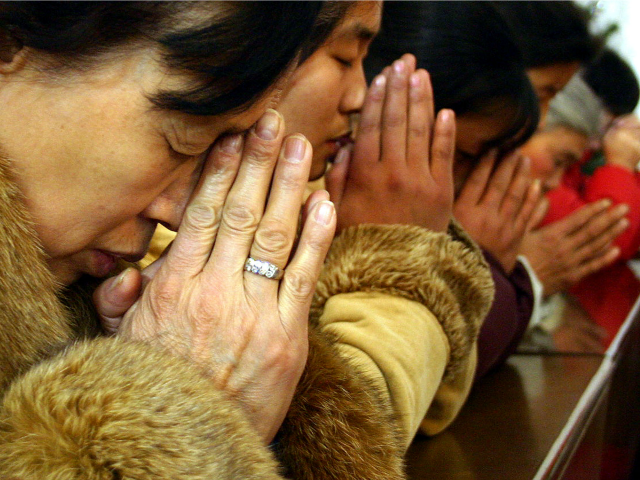Bishops of China’s state-controlled Catholic Patriotic Association (CCPA) have told dioceses to draft local versions of a national “Sinicization” program to bring the Catholic Church into line with the ideals of the Communist party.
In June, the CCPA, together with the collaborationist Bishops’ Conference of the Catholic Church in China (BCCCC), delivered a 15-page, five-year Sinicization program to all dioceses, and now have directed the dioceses to create their own modified five-year plans by the end of August, ucanews reported this week.
The Sinicization effort is being carried out according to new regulations that have tightened government control over all religious activities in China. The regulations, which came into effect on February 1, outlaw all acts of worship outside of designated church structures and government-authorized schedules.
The new policy also forbids minors under the age of 18 from taking place in any religious services, mandating that a notice to this effect be posted at the door of all church buildings.
In the text of the CCPA Sinicization plan, which has 6,500 words and nine major points, the word “Sinicization” appears 72 times. Churches in two Chinese provinces—Hebei province and the Yibin Diocese of Sichuan province—have already held training seminars on the five-year plan to promote Sinicization.
The plan seeks to “complete the Chinese-style socialist road within five years,” a source in Hibei province told ucanews. “Even if they do not get approval from the Holy See, they will still get trust from the government.”
In March, one Chinese bishop of the CCPA announced that loyal citizenship must take priority over Christian faith.
Bishop Peter Fang Jianping of Tangshan said that Catholics should give their allegiance to President Xi Jinping “because we, as citizens of the country, should first be a citizen and then have religion and beliefs.”
Fang, who was ordained a bishop in China without Vatican approval in 2000 and later legitimized by the Holy See, is a member of the National People’s Congress (NPC), the Chinese parliament that on March 11 voted to eliminate presidential term limits.
Asked about church-state relations, the bishop justified the subjection of the faith to political powers by citing Jesus’ command to render to God what is God’s and to Caesar what is Caesar’s.
Although exact figures are unavailable, some 12 million Catholics are believed to currently be living in China, split roughly 50-50 between the CCPA and the illegal “underground Church” of those faithful to Rome.
Since President Xi took power in 2013, authorities have removed some 1,500 crosses from Christian church buildings, usually by citing irregularities in building permits, as part of China’s program of “Sinicization.”
The Vatican’s Foreign Minister said in March that “Sinicization” is one of the keys to the future of Christianity in China, as the Vatican continues trying to broker a historic agreement with the Chinese government.
Archbishop Paul Richard Gallagher, the Secretary for Vatican Relations with States, embraced the concept of Sinicization in his opening address at an international conference on Christianity in China, held at the Jesuit-run Gregorian University in Rome.
It seems clear that the mission of the Church in China today is one of being “fully Catholic and genuinely Chinese,” making the Gospel of Jesus available to all and placing it at the service of the common good, Gallagher said.
“Sinicization,” or assimilation into a Chinese culture and worldview, has been a leitmotiv of Xi’s government, as part of a larger effort to progressively gain tighter control over all institutions active on Chinese soil.
President Xi has made it clear that all religions active in China must be rendered compatible with the beliefs and programs of Communist China and purged of western influence and oversight.
According to Daniel Mark, chairman of the U.S. Commission on International Religious Freedom, Sinicization of religion is very different from inculturation and ends up twisting religion to the ends of “one of the world’s most repressive regimes.”
The Sinicization of religion, Mark stated in an article titled “The Vatican’s China Whitewash,” is in reality “a process of manipulating and subduing faith so as to render it compatible with the state’s totalitarian aims.”
As the collaborating state-run church continues its voluntary reeducation, the XI government continues persecuting Christians who do not wish to burn incense to the emperors.
In June, government officials used backhoes and pickup trucks to demolish the sanctuary of Our Lady of Mount Carmel, a popular Catholic pilgrimage site in China’s Henan province since its founding in 1903.
Local communist authorities came in the evening and tore down the shrine’s images of Christ along the Way of the Cross, reportedly because “authorities feared there would be too many church members in the daytime.”
Each year on July 16 thousands of pilgrims travel to the shrine from nearby provinces, such as Hebei and Shanxi, to celebrate the feast of Our Lady of Mount Carmel. In 1987, the government outlawed large religious gatherings and limited the number of pilgrims to 300.
Follow Thomas D. Williams on Twitter Follow @tdwilliamsrome

COMMENTS
Please let us know if you're having issues with commenting.